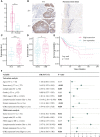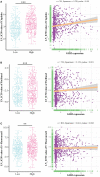The prognostic value and biological significance of gap junction beta protein 2 (GJB2 or Cx26) in cervical cancer
- PMID: 35936685
- PMCID: PMC9355537
- DOI: 10.3389/fonc.2022.907960
The prognostic value and biological significance of gap junction beta protein 2 (GJB2 or Cx26) in cervical cancer
Abstract
Objective: To evaluate the prognostic value and explore the biological significance of gap junction protein beta 2 (GJB2 or Cx26) in cervical cancer (CC).
Methods: We first compared GJB2 expression between CC and normal tissues using public databases and immunohistochemistry (IHC). Based on The Cancer Genome Atlas data (TCGA cohort, n = 304) and tissue microarray samples (OBC cohort, n = 111), we explored the prognostic value of GJB2 for CC patients using bioinformatics analysis and IHC scoring. To explore the biological significance of GJB2, Gene set enrichment analysis (GSEA) and Gene Ontology (GO) were performed. The impact of GJB2 on the immune microenvironment was analyzed by CIBERSORTx and ESTIMATE algorithms. We finally investigated the relationship between GJB2 and drug sensitivity based on the Genomics of Drug Sensitivity in Cancer (GDSC).
Results: The expression of GJB2 was significantly increased in CC over normal tissues. Both the TCGA and OBC cohort found that patients with high GJB2 expression had shorter overall survival (OS) time, and high GJB2 expression was the independent risk factor for prognosis (TCGA: HR, 2.566; 95% CI, 1.066-6.180; p = 0.036; OBC: HR, 2.198; 95% CI, 1.019-4.741; p = 0.045). GJB2 was correlated with patient clinical factors such as tumor size and differentiation grade. The p53 signaling pathway and toll-like receptor pathway may be regulated by GJB2. The abundance of various immune cells was significantly different between the low and high GJB2 expression groups. The ImmuneScore was significantly increased in the high GJB2 expression group. In addition, the expression level of GJB2 was positively correlated with the natural log of the half-maximal inhibitory concentration (LN_IC50) value of cisplatin/paclitaxel (Spearman r = 0.238/0.153, p < 0.001).
Conclusion: GJB2 can serve as a potential prognostic marker of poor survival and a therapeutic target in CC. Moreover, GJB2 may affect the immune microenvironment and is correlated with chemoresistance.
Keywords: GJB2; cervical cancer; chemoresistance; immune cell abundance; prognostic marker.
Copyright © 2022 Meng, Liu, Wang, Wu, Xie, Kang, Liu, Guo and Wang.
Conflict of interest statement
The authors declare that the research was conducted in the absence of any commercial or financial relationships that could be construed as a potential conflict of interest.
Figures




Similar articles
-
Ion channel gene GJB2 influences the intercellular communication by Up-regulating the SPP1 signaling pathway identified by the single-cell RNA sequencing in lung adenocarcinoma.Front Oncol. 2023 Apr 28;13:1146976. doi: 10.3389/fonc.2023.1146976. eCollection 2023. Front Oncol. 2023. PMID: 37188183 Free PMC article.
-
GJA1 Expression and Its Prognostic Value in Cervical Cancer.Biomed Res Int. 2020 Nov 24;2020:8827920. doi: 10.1155/2020/8827920. eCollection 2020. Biomed Res Int. 2020. PMID: 33299882 Free PMC article.
-
Prognostic value of CCR2 as an immune indicator in lung adenocarcinoma: A study based on tumor-infiltrating immune cell analysis.Cancer Med. 2021 Jun;10(12):4150-4163. doi: 10.1002/cam4.3931. Epub 2021 May 4. Cancer Med. 2021. PMID: 33949150 Free PMC article.
-
Genome-scale analysis identifies GJB2 and ERO1LB as prognosis markers in patients with pancreatic cancer.Oncotarget. 2017 Mar 28;8(13):21281-21289. doi: 10.18632/oncotarget.15068. Oncotarget. 2017. PMID: 28177904 Free PMC article.
-
Comprehensive analysis of prognostic immune-related genes and drug sensitivity in cervical cancer.Cancer Cell Int. 2021 Dec 1;21(1):639. doi: 10.1186/s12935-021-02333-9. Cancer Cell Int. 2021. PMID: 34852825 Free PMC article.
Cited by
-
A novel method for detecting nine hotspot mutations of deafness genes in one tube.Sci Rep. 2024 Jan 3;14(1):454. doi: 10.1038/s41598-023-50928-1. Sci Rep. 2024. PMID: 38172427 Free PMC article.
-
Intercellular cross-talk through lineage-specific gap junction of cancer-associated fibroblasts related to stromal fibrosis and prognosis.Sci Rep. 2023 Aug 30;13(1):14230. doi: 10.1038/s41598-023-40957-1. Sci Rep. 2023. PMID: 37648762 Free PMC article.
-
GJB2 enhances cancer stem cell properties by modulating SOX2 expression via NF-κB pathway activation in lung adenocarcinoma.Transl Cancer Res. 2025 May 30;14(5):2648-2660. doi: 10.21037/tcr-24-2075. Epub 2025 Apr 27. Transl Cancer Res. 2025. PMID: 40530159 Free PMC article.
-
Downregulation of RhoB Inhibits Cervical Cancer Progression and Enhances Cisplatin Sensitivity.Genes (Basel). 2024 Sep 10;15(9):1186. doi: 10.3390/genes15091186. Genes (Basel). 2024. PMID: 39336777 Free PMC article.
-
Pan-cancer ion transport signature reveals functional regulators of glioblastoma aggression.EMBO J. 2024 Jan;43(2):196-224. doi: 10.1038/s44318-023-00016-x. Epub 2024 Jan 2. EMBO J. 2024. PMID: 38177502 Free PMC article.
References
-
- Utada M, Chernyavskiy P, Lee WJ, Franceschi S, Sauvaget C, de Gonzalez AB, et al. . Increasing risk of uterine cervical cancer among young Japanese women: Comparison of incidence trends in Japan, south Korea and Japanese-americans between 1985 and 2012. Int J Cancer (2019) 144(9):2144–52. doi: 10.1002/ijc.32014 - DOI - PMC - PubMed
LinkOut - more resources
Full Text Sources
Research Materials
Miscellaneous

